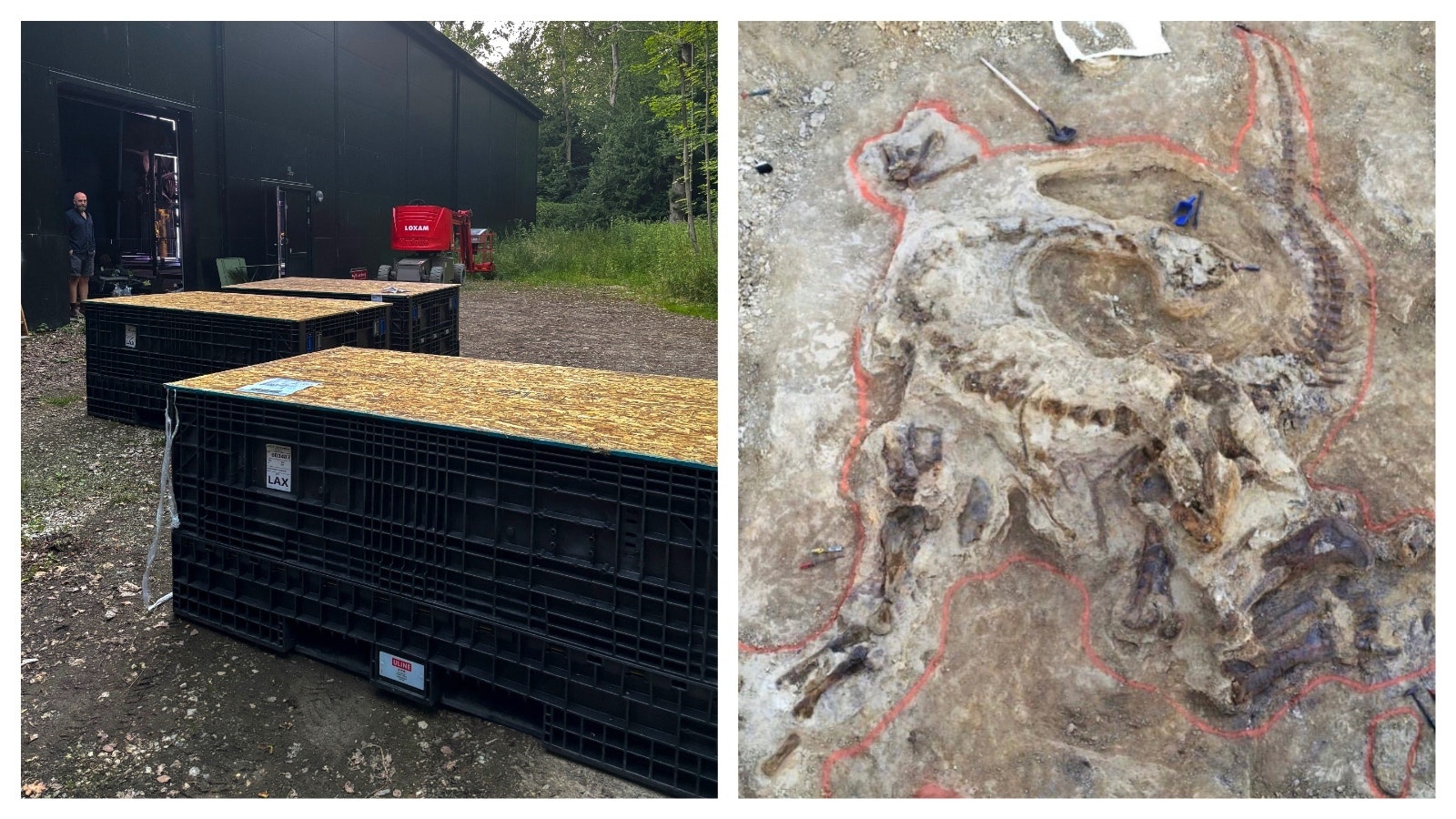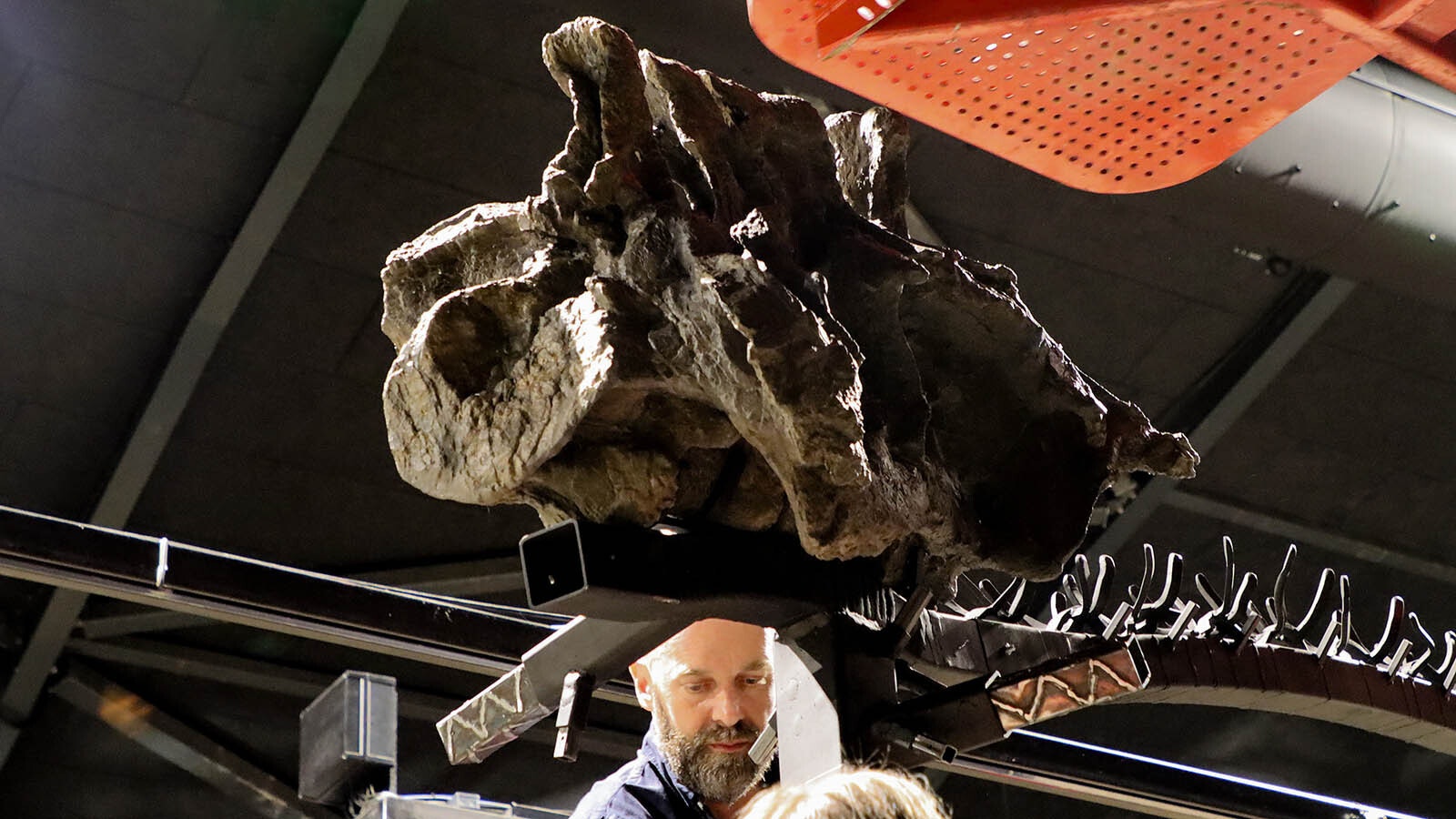The Evolution Museum at Knuthenborg Safari Park in Denmark has unveiled its newest animal attraction: a 150-million-year-old Camarasaurus, discovered in a quarry in Wyoming’s Bighorn Basin.
But the dinosaur’s journey from the Cowboy State turned harrowing when the massive, long-necked Camarasaurus was flown from Utah to Denmark, but got lost for a week along the way.
Christoffer Knuth, director of the Museum of Evolution, told Cowboy State Daily that the fossilized skeleton was notable for its “exceptional preservation.” More than 97 percent of the 43-foot-long giant’s bones were recovered, most of them still connected together as they were when the dinosaur was alive.
“Such completeness is rare and provides in-depth information about the dinosaur’s anatomy and lifestyle, making it a crucial piece for public display and scientific study,” he said.
Papers please
Camarasaurus, a herbivorous sauropod, is one of the most common dinosaurs from the late Jurassic period, more than 146 million years ago. Knuth said the specimen acquired by the Museum of Evolution was discovered in 2017 and excavated from a quarry in Ten Sleep in May 2019.
“After being exhumed, Camarasaurus underwent more than 12,000 hours of painstaking restoration in Utah,” he said. “The specimen was then shipped from Utah to the Museum of Evolution in Denmark.”
But the journey of this enormous sauropod was not easy.
After the specimen was meticulously packed for the transatlantic voyage to Denmark, it made an extended and unexpected stopover in Switzerland.
“The specimen was shipped directly from Utah, but was mistakenly registered at customs upon arrival in Switzerland,” Knuth said. “This registration error extended the transit period of normally one week to two weeks before the shipment continued to Denmark.”
There was even a time when the dinosaur disappeared between Switzerland and Denmark. Since it had been transported in several containers, it took several trackers to follow the specimen’s journey, and their information got mixed up.
Once the Wyoming dinosaur was discovered in the Swiss capital of Zurich and confirmed as Danish property, it successfully reached its new home at the Museum of Evolution – much to the relief of Knuth and his peers, who are thrilled to have such a large and exceptionally well-preserved dinosaur in their collection.
“This is a world-class specimen,” he said.
Sauropod Expedition
Levi Shinkle, former collections manager at the Wyoming Dinosaur Center, has shipped many fossils within the United States and abroad. He knows how difficult it can be to get a dinosaur to its destination.
“We shipped one to Germany in 2021, and it took forever to get there,” he said. “It certainly spent some time in a warehouse overseas while we tried to figure out where it was or how to get it there. Another time, we were told a dinosaur was somewhere between Los Angeles and Frankfurt. It ended up getting held up in customs in London.”
Shinkle explained that shipping dinosaurs overseas always poses customs issues, but the biggest challenge is preparing the fossils for shipping. It takes a lot of time to acquire the supplies and certifications needed to meet the strict standards of international shipping.
“If you’re using a container or crate that has solid wood in it, it has to be certified so you’re not accidentally shipping an invasive species to another country,” he said. “If you’re making it entirely out of plywood, that’s not a problem, but plywood is not as strong as solid wood.”
The strength of wood is essential when transporting dinosaur fossils. A single fossilized bone from a Camarasaurus can weigh over 500 pounds, while being as thin as tissue paper in some places.
Wyoming isn’t known as an international shipping hub, which has posed a particular challenge for Shinkle and the Wyoming Dinosaur Center. The commercial resources used to package anything, let alone dinosaurs, aren’t always accessible in places like Thermopolis, if they can be found at all.
“We don’t have access to a Lowe’s or a Home Depot or any other specialty delivery service in Thermopolis,” he said. “We had to get creative, which took a lot more effort.”
Reuse and recycle
Whenever Shinkle needed to prepare a fossil for shipment, he often had to build a custom crate or container. The easiest way to do this was to disassemble old crates from previous international expeditions at the Wyoming Dinosaur Center and use the wood to make new crates.
“We would get stamped crates from other countries, and we would rebuild them from those stamped crates and add plywood and other materials like that,” he said. “We would also use crates with pieces of plywood cut and glued as supports to make them stronger. Recycling was very helpful to us.”
Each fossil had to be securely placed in its transport crate. If it was not secured properly, if it moved too much during transport, or if it bumped into other fossils during the journey, a fossil could break into pieces before reaching its destination.
Without a readily available source of quality packaging, Shinkle had to improvise. He found solutions in local businesses.
“To get a good stuffing, we would go to the local quilt store and wrap the fossils in quilt batting,” he explained. “Then we would use household foam insulation, because it comes in sheets about the same size as plywood. We would stack them, cut holes in them, put the fossils in those holes, and stuff it with batting and stuffing so it wouldn’t move.”
Using recycling techniques and locally sourced supplies, Shinkle made sure that each fossil was well packaged, no matter where it was going, no matter when it arrived. Dinosaurs may be impressive once assembled, but they don’t get any special treatment during transport.
“From a shipping perspective, it’s just shipping a bunch of rocks,” he said.
Dinosaurs on international wings
Dinosaurs like Camarasaurus could not fly, but dinosaurs from Wyoming are constantly being brought to museums around the world to fly. In addition to those from Denmark, specimens of Camarasaurus from Wyoming are on display in the dinosaur halls of museums in France, Japan, and Switzerland.
The Museum of Evolution already had a dinosaur from Wyoming in its collection before the arrival of its Camarasaurus. “Big Joe,” an Allosaurus, has been described as the best-preserved specimen of its species ever discovered, with more than 95 percent of its skeleton preserved.
Knuth said the Museum of Evolution plans to expand its collection of Wyoming dinosaurs. Another specimen found in the same Ten Sleep quarry as the Camarasaurus is already headed to Denmark.
“We are announcing our intention to introduce another dinosaur from the same Wyoming quarry next year,” he said. “The museum continually seeks to enhance its exhibits, including some of the best-preserved and most unique dinosaur fossils in the world, thereby enriching scientific research and public education about the history of evolution.”
Contact Andrew Rossi at arossi@cowboystatedaily.com

Andrew Rossi can be contacted at arossi@cowboystatedaily.com.




